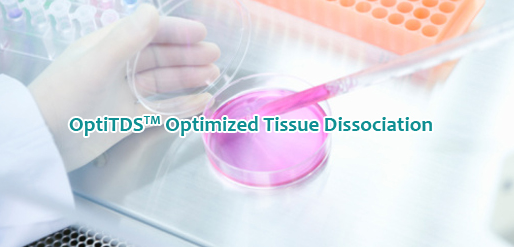 Successful culture of primary cells requires obtaining a maximum yield of functionally viable single cells from whole tissues. The primary factors that affect successful dissociation of whole tissue have to do with tissue origin, species, age of the animal, the dissociation medium and enzyme(s) used, the amount of impurities in any crude enzyme preparation, the concentration(s) of enzyme(s), and the temperature and incubation times. While factors dealing with type of tissue and species cannot be controlled, conditions associated with tissue dissociation are manageable.
Successful culture of primary cells requires obtaining a maximum yield of functionally viable single cells from whole tissues. The primary factors that affect successful dissociation of whole tissue have to do with tissue origin, species, age of the animal, the dissociation medium and enzyme(s) used, the amount of impurities in any crude enzyme preparation, the concentration(s) of enzyme(s), and the temperature and incubation times. While factors dealing with type of tissue and species cannot be controlled, conditions associated with tissue dissociation are manageable.
Dissociation impacts yield & viability…
To obtain a maximum yield of functionally viable, single cells, the choice of the most appropriate enzymes in the correct ratios are crucial, including the appropriate incubation times with the tissues. Aggressive dissociation or poor dissociation of tissues will result in low cell viability. Outlined below are some possible explanations for sub-optimal cell isolation and the solutions to obtain the most optimal results.
1) Low yield and low viability: Most likely tissues are dissociated too aggressively which results in cellular damage. Change the type of enzyme and/or decrease the working concentration. (e.g. from trypsin to collagenase/ from Type 2 collagenase to Type 1).
2) Low yield and high viability: The tissues are digested gently using enzymes that are too mild or the incubation time is too short. Increase the enzyme concentration and/or the incubation time and monitor both the yield and the viability response. If the yield remains poor, evaluate a stronger digestive type of enzyme and/or the addition of secondary enzyme(s).
3) High yield and low viability: The tissues are probably digested with the appropriate enzymes but the enzyme composition is too strong and/or at a high working concentration that causes cellular damage. Reduce the concentration and/or the incubation time and monitor the yield and the viability response. Alternatively, dilute the proteolytic action by adding bovine serum albumin (BSA) (0.1 – 0.5% w/v) or soybean trypsin inhibitor (0.01 – 0.1% w/v) to the enzyme mixture.
4) High yield and high viability: These conditions strike the optimal balance for the selected tissues.
 Trituration is also a crucial part of primary cell isolation!
Trituration is also a crucial part of primary cell isolation!
In addition to the dissociation procedures mentioned above, trituration can be a crucial part of primary cell isolation. This action of repeatedly pipetting the mixture allows the tissues to break up into fragments, after the tissues have been incubated in the dissociation enzymes. If done too vigorously, cells will be destroyed lowering viability; if done too weakly, tissue fragments will be left intact, thus lowering the yield.
The correct method is to use gentle trituration, using a 10 ml pipette by filling and emptying the barrel at a rate of about 3.0 ml per sec. The best method to determine a suitable trituration rate for the tissue of choice is through trial and error, being cautious to avoid any bubbles in the cell suspension.
How to get started?
Establishing a protocol for primary cell isolation is a long and tedious process, more empirical than rational. Determining the right enzymes to be used (single enzyme or cocktail?), the right concentration, dissociation time, etc can sometimes take more than 8 weeks, costs money and uses precious tissue samples.
A time & cost effective solution!
The tissue dissociation system, OptiTDS™, is a proprietary mixture of several tissue dissociation enzymes/reagents with appropriate distribution ratios resolved in an optimum buffer, to produce a maximum number of single viable cells . Each tissue dissociation system is customized to be tissue-specific and cell-specific, to bring you the best results for each type of the primary cultured cells.
Components: Each OptiTDS™ system contains (1) concentrated tissue dissociation enzymes/reagents (2 x 1.0 ml) (2) tissue-specific optimum tissue dissociation digestion buffer system (2 x 9.0 ml).
Quantity and Quality Controls: Each OptiTDS™ kit consists of 20 ml of tissue dissociation enzyme working solution that is sufficient for 3-5 g of tissue samples. Each lot is tested for optimum performance of tissue dissociation on tissue samples from Human, Mouse and Rat, and provides freshly prepared reagent solutions.
A final tip! To find the right OptiTDS™ system for your protocol, just type in our search engine the species and tissue you are working with. For example, “OptiTDS AND MOUSE AND LIVER” will give these results: www.tebu-bio.com/s/98mack




